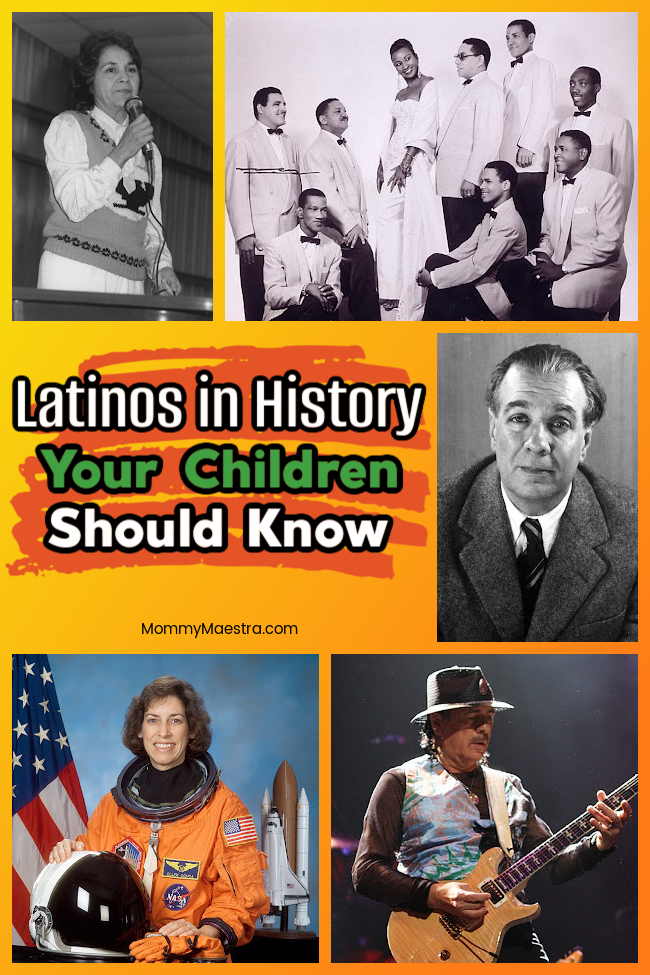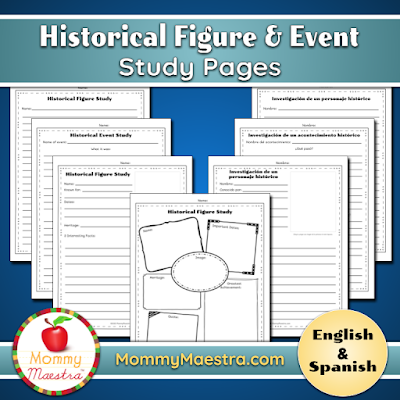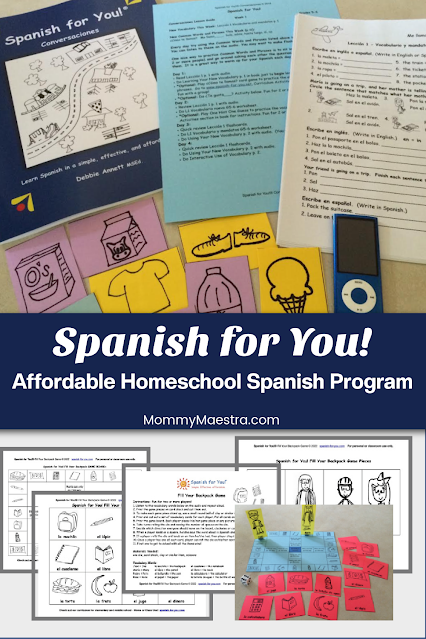 The contributions of Hispanics to U.S. and world history are numerous. They've impacted every aspect of history, including the arts, music, literature, science, math, politics, athletics, conservation, education, and on and on. I've written a lot about specific figures and shared my research and resources for introducing some of these important people to your students and children. So I decided that I really needed a single post that links back to the posts featuring these remarkable men and women of Hispanic and Latino heritage.
The contributions of Hispanics to U.S. and world history are numerous. They've impacted every aspect of history, including the arts, music, literature, science, math, politics, athletics, conservation, education, and on and on. I've written a lot about specific figures and shared my research and resources for introducing some of these important people to your students and children. So I decided that I really needed a single post that links back to the posts featuring these remarkable men and women of Hispanic and Latino heritage.
This is just a beginning. There are many more figures that I'll be adding to this list, and some I've already added that have features in the works. I hope you'll bookmark this page and check back frequently to learn about more notable Hispanics in history.
Where possible, I have linked to student/child-friendly posts or sites. If there is no link, I have not found anything age appropriate yet, and will work to add a page to my site.
 |
| Diego and Frida. Archives of American Art, Smithsonian Institution |
Hispanic Artists
You will probably recognize most of the names on this current list. But I bet there are one or two you'll learn more about!
- Frida Kahlo Lesson Plans, Activities, Coloring Sheets and More
Frida was a Mexican artist who is best known for her self portraits. Her fame is worldwide but she has a huge following here in the United States. She was married to Diego Rivera.
- Diego Rivera Lesson Plans, Books, and More
Diego was a Mexican muralist who focused his artwork on highlighting the stories and struggles of the working class. He was married to Frida Kahlo.
- Joan Miró Activities, Crafts, Lesson Plans and More (Hispanic not Latino)
Joan was a Spanish painter and sculptor. His unique art is recognizable and makes him a great subject for school art projects.
- Pablo Picasso Lesson Plans, Activities, Coloring Pages, and More (Hispanic not Latino)
Picasso's fame is almost universal. And his Cubist style makes him a great subject for students.
- A Mini-Lesson on Bill Meléndez
Not many people know that the Peanuts' TV animator was Mexican-American. He was also the voice of Snoopy!
- José Guadalupe Posada Lesson Plans
José was a Mexican artist who specialized in lithographs (and engravings). He's best known for his Day of the Dead illustrations that were politically charged.
- Salvador Dalí (Hispanic not Latino)
Dalí was a Spanish painter. He is best remembered for his Surrealist paintings that feature dream-like subjects, merging reality and illusion.
- José Clemente Orozco
Orozco was a Mexican painter who led the muralist movement.
- Carolina Herrera
Carolina Herrera is a famous Venezuelan- American fashion designer. Her clothing line has been worn by women all over the world, including several U.S. first ladies, including Michelle Obama.
 |
| Jroses, CC BY-SA 3.0, via Wikimedia Commons |
Latino Writers
- Sor Juana Inés de la Cruz: Lesson Plans, Videos, and Books for Kids
Sor Juana Inés de la Cruz was a 17th-century nun, self-taught scholar, and poet. Her writings make her a major figure of the the Spanish Golden Age.
- Pablo Neruda: Lesson Plans, Videos, Books, & More
Neruda was a Chilean poet, diplomat, and politician. He is best remembered for his poetry that reflected his love of his country.
- Julia de Burgos
Burgos García was a Puerto Rican poet, and a civil rights activist for women and African/Afro-Caribbean writers.
- Isabel Allende
Allende is a Chilean-American writer and journalist. She's considered Latin America's most successful female novelist and her books have sold more than 56 million copies world wide.
- Miguel de Cervantes (Hispanic not Latino)
Miguel de Cervantes was a Spanish novelist, poet, and playwright. His most well known work - “Don Quixote” - was an instant international bestseller and is considered the first Modern Novel.
- Gabriel García Márquez
García Márquez was a Colombian novelist, journalist, short-story writer, and screenwriter. He's considered Latin America's most famous author. His stories mastered the style of magical realism and are beloved by most Latin Americans.
- Gabriela Mistral
Gabriela Mistral was a poet, educator, and diplomat. She was the first Latin American writer to receive the Nobel Prize for Literature in 1945.
- José Martí
Martí was a Cuban poet, essayist, journalist, translator, professor, and publisher. He was also dedicated to Cuba's independence from Spain and is considered a national hero.
- Jorge Luis Borges
Borges was an Argentine writer and poet, who is considered one of the major literary figures of the 20th century.
- Carlos Fuentes
Fuentes was, perhaps, Mexico's most famous novelist and essayist.
- Rudolfo Anaya
Anaya was a Mexican-American writer and novelist who has been called a Father of Chicano Literature for his groundbreaking works that reflect the American Southwest and especially the Mexican-American culture.
- Federico García Lorca (Hispanic not Latino)
García Lorca was a Spanish poet, playwright, and theatre director. He is considered to be one of the most important Spanish poets of the twentieth century.
- Soledad O’Brien
O’Brien is a national broadcast journalist and philanthropist. She is best known for anchoring and co-anchoring several news shows for major networks such as NBC, CNN, and HBO.
- Sandra Cisneros
Sandra Cisneros is a Chicana poet and novelist famed for her first novel “The House on Mango Street.” She was the first female Mexican-American writer to be published by a mainstream publisher and has won numerous awards for her work.
- Juan Felipe Herrera
Herrera is a poet, performer, writer, cartoonist, teacher, and activist. He was also the 21st United States Poet Laureate from 2015 to 2017.
- Octavio Paz
Octavio Paz Lozano was a Mexican poet and diplomat. In 1990, he was awarded the Nobel Prize in Literature “for impassioned writing with wide horizons, characterized by sensuous intelligence and humanistic integrity.”
.jpg) |
| http://science.in2pic.com, via Wikimedia Commons |
Hispanic Scientists
- Mario José Molina
Dr. Molina is one of the researchers who discovered the horrifying effects of CFCs on our planet's protective ozone layer. His research led to world-wide change.
- Franklin Ramón Chang Díaz
Franklin Díaz is a Costa Rican-American physicist, mechanical engineer, and former NASA astronaut. He has flown on seven space shuttle missions making him the record holder for the most spaceflights. He now runs a company that makes high-speed rocket systems.
- Ellen Ochoa
The first Latina in space, Dr. Ochoa, was also the first Latina director of the Johnson Space Center. She has spent nearly 1,000 hours in space aboard four different missions.
- Carlos Juan Finlay
Dr. Finlay was a Cuban epidemiologist who discovered that yellow fever is transmitted through mosquitoes.
- Lydia Aguilar-Bryan (a good read for educators/adults)
Together with her husband, Lydia discovered how the body regulates the secretion of insulin, a hormone that controls the amount of sugar in our blood.
- Guillermo González Camarena
Camarena was a Mexican electrical engineer who was the inventor of a color-wheel type of color television.
- Manuel “Manny” Villafaña
Villafaña is an entrepreneur of medical devices. His businesses have mainly concentrated on heart health devices such as pacemakers and heart valves. His work has saved hundreds of thousands of lives.
- Helen Rodríguez Trías
Dr. Trías was a pediatrician, educator and women rights activist. She was the first Latina president of the American Public Health Association. Dr. Trías received the Presidential Citizen's Medal for her work on behalf of minorities and the poor.
 |
| Trikosko, Marion S., photographer, Public domain, via Wikimedia Commons |
Latino Activists & Teachers
- Arturo Alfonso Schomburg Resources
Schomburg was an Afro-Latino from Puerto Rico whose foresight and diligence helped create and establish the largest collection dedicated to Africans and the African diaspora.
- Cesar Chavez Lesson Plans, Activities, Coloring Sheets and More
Chavez was a Mexican-American labor leader and civil rights activist, who fought for better working conditions for farm workers. Together with Dolores Huerta, he co-founded the National Farm Workers Association.
- Dolores Huerta Lesson Plans, Activities, Coloring Sheets and More
Dolores Huerta is a Mexican-American civil rights activist, who has fought for better working conditions for farm workers and other hard- working families. Together with Cesar Chavez, she co-founded the National Farm Workers Association.
- Las Adelitas for Kids & Young Adults
Las Adelitas were the women in the military - many of whom bravely joined their male family members and sweethearts to fight - in the Mexican Revolution.
- Sylvia Mendez
Sylvia Mendez is a civil rights activist whose family played a crucial role in the Mendez v. Westminster case in 1946. It was the first case for the integration of schools won in California, and paved the way for the desegregation of schools in the United States.
- Ralph Lazo
Lazo was the only known non-spouse, non-Japanese American who voluntarily relocated to a World War II Japanese American internment camp in support of his friends. He later helped raise funds for a class-action lawsuit to win reparations for the Japanese Americans interned.
- Willie Velásquez
Willie Velasquez was a grassroots activist and vote organizer. Perhaps no one has had a greater impact on American politics by empowering Hispanic citizens to run for office.
- Jovita Idár
Jovita Idár was a journalist and civil rights activist who fought for the rights of Mexican American families and Mexican immigrants, as well as for equal education for Mexican American children and women’s suffrage.
- Jaime Escalante
Escalante was a Bolivian immigrant who taught math at an L.A. high school. His teaching style and methods helped students believed to be "unteachable" to master calculus and many pursued higher education.
 |
| Ibrahim Arce (Narcy Studios photographer), most likely, Public domain, via Wikimedia Commons |
Hispanic Musicians
- Vicente Fernández Reading Passage
Vicente Fernández was a Mexican singer, actor, and film producer. He is best known for his ranchera songs. Fernández is considered one of the best-selling artists from Mexico of all time.
- Tito Puente Lesson Plans, Coloring Pages, Crafts, Activities and More
Tito was an American musician and Latin jazz composer. Dubbed the King of Mambo, Puente was famous for his ability to play the timbales, a type of drum set. He was awarded the National Medal of Arts.
- Selena Quintanilla Perez
Tejano music’s most cherished icon, known simply as Selena, broke many records before her unexpected death at the age of 23.
- Celia Cruz
Best known as the “Queen of Salsa,” Celia Cruz was a Cuban singer who introduced the world to vibrant music with her amazing voice and flamboyant costumes.
- Carlos Santana
Carlos Santana is a guitarist, composer, and singer. He is known for his unique musical style blending rock music with Latin American rhythms. Listed as one of the 100 Greatest Guitarists of All Time, he has won 10 Grammy Awards and 3 Latin Grammy Awards.
- Linda Ronstadt
Ronstadt is a famous American singer and one of the bestselling artists of all time. She was the first female singer to sell out concerts. Ronstadt has made more than 120 albums that have sold more than 100 million records.
- Gloria Estefan
Estefan is a Cuban-American singer, actress, and businesswoman. She's best known as the lead singer of the Latin Pop group Miami Sound Machine.
- Placido Domingo (Hispanic not Latino)
Plácido Domingo is a Spanish tenor opera singer. He has recorded over 100 complete operas and has performed in Italian, French, German, Spanish, English, and Russian in the most prestigious opera houses in the world.
- Martina Arroyo
Arroyo is an American opera singer. Martina’s father was from Puerto Rico and her mother was from Charleston, South Carolina. She is one of the first African Americans to have a successful international career in opera.
Latinx Athletes
- Dara Torres
Dara Torres is a five-time Olympic swimmer and former world record-holder in three events. The only swimmer to compete in five different Olympic games, she was also the oldest swimmer to ever earn a place on the Olympic swimming team when she was 41 years old.
- Roberto Clemente
Roberto Clemente was a famous Puerto Rican baseball player and philanthropist. He played for the Pittsburgh Pirates, where he became a player of exceptional skill. He set several records and made baseball history.
- Rafael Nadal
Nadal is a Spanish tennis player and record title holder. Nicknamed “The King of Clay,” he is considered to be the greatest clay court player of all time. Nadal’s incredible success has established him as one of the greatest tennis players in history.
 |
| Sonia Sotomayor, U.S. Supreme Court justice |
Other Notable Hispanics
- Sonia Sotomayor
Sotomayor is the first Latina to become a Supreme Court Justice in the United States. She has been appointed to be a judge in three courts by three different presidents, and was also the first Hispanic federal judge in New York State.
- Rita Moreno
Moreno is a famous Puerto Rican dancer, singer, and actress best known for playing the role of Anita in the movie “West Side Story.” She is the only Hispanic to ever win all 4 major American entertainment awards: an Oscar, a Grammy, a Tony, and an Emmy.
- Pura Belpré
Belpré was the first Puerto Rican librarian in New York City. She pioneered the library’s outreach program in the Latino community. Belpré was also a writer, collector of folktales, and a puppeteer.
- Sonia Manzano
Manzano is an actress and writer best known for her role as “María” on Sesame Street. She’s won 15 Emmy Awards as part of the show’s writing team and has helped millions of American children develop the skills they need to start school.
- Sammy Davis, Jr.
Sammy Davis Jr. was a famous Afro-Cuban-American entertainer. He was a member of the famous “Rat Pack,” a group of actors that appeared together in films and on stage. The group included actors Frank Sinatra and Dean Martin.
- Bernardo de Gálvez
Gálvez was a Spanish military leader who helped the 13 original colonies gain independence. He led Spanish forces against Britain in the Revolutionary War and defeated the British at the Siege of Pensacola. Galveston, Texas, was named after Gálvez.

Why it is important for Hispanic children to learn about their culture and history
So many studies have shown that Hispanic children who grow up knowledgeable and proud of their culture have lower drop out rates, better academic achievements, higher graduation rates, less substance abuse problems, and are less likely to be incarcerated.
It doesn't take a rocket scientist to figure out that being proud of who you are and where you came from gives you confidence and the motivation to make your ancestors proud and leave your own mark on history.
In fact, a 2016
study conducted by scholars at Stanford Graduate School of Education found that ethnic studies classes dramatically helped struggling students - of all backgrounds.
A high school ethnic studies course examining the roles of race, nationality and culture on identity and experience boosted attendance and academic performance of students at risk of dropping out...
So this is why I focus on sharing the stories of Hispanics with you through books, articles, and printable activities. I know it makes a difference in your children's lives.
You can find most of my resources here in my shop or in my
TpT store.
Have Your Kids Do Their Own Research

- The historical figures are arranged by century starting with the 1400s to the present
- The historical figures are arranged by field of influence, including musicians, artists, activists, scientists, athletes, writers, journalists, actors, leaders & politicians, and other notable figures.
Pages for note-taking, research, and one-page presentations are included, as are additional pages for comparing/contrasting historical figures, word association, and listing new vocabulary. In addition, it contains printable date cards and information labels for creating a timeline display on a wall. Instructions are included.
And as always, this entire packet is available in both English and Spanish. Simply select the version that best suits your needs.
Or you may prefer to simply assign a historical figure or event to your student(s) and have them do the research. These study pages help guide the student in what information to look for and record. Can be used for ANY historical figure or event.
You May Also Like Learning About...
Here are some of my other posts and reading passages that you may enjoy.

















.jpg)


















